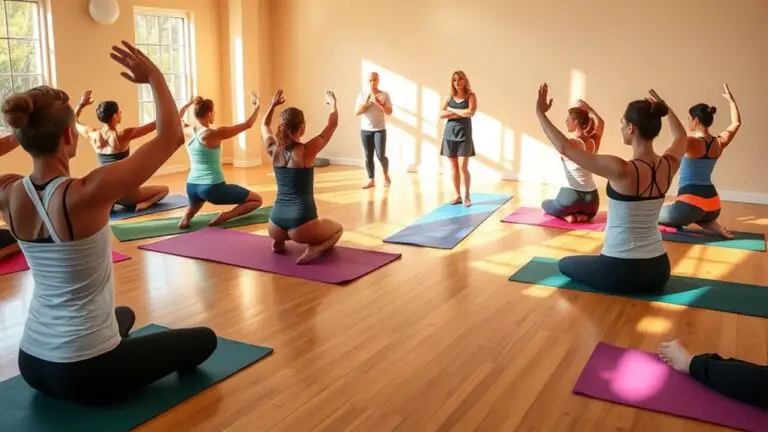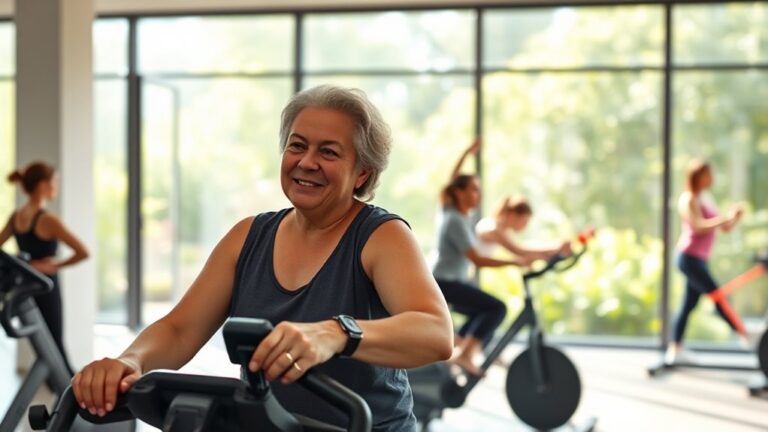The Best Recovery Techniques for Gym Athletes
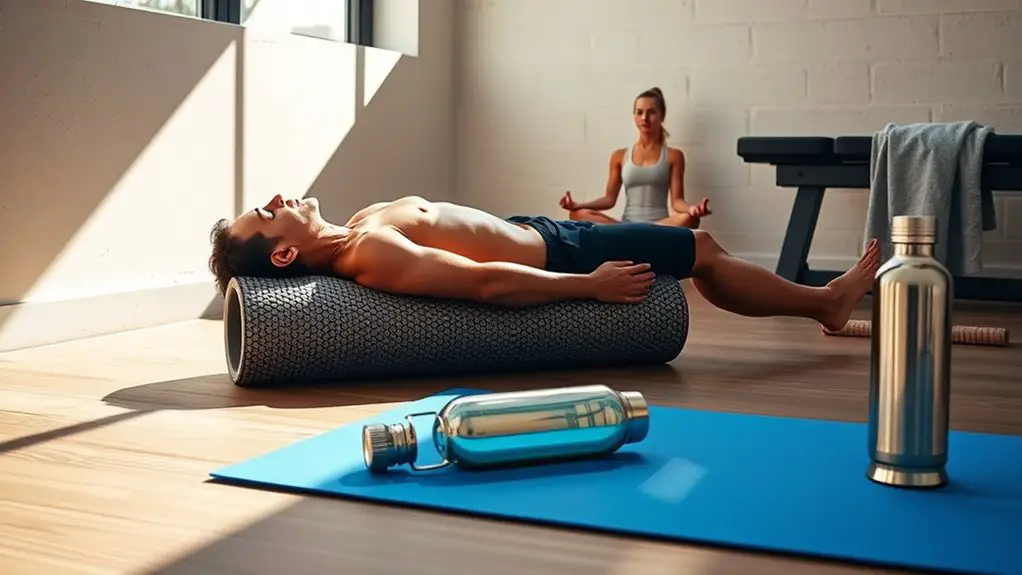
To optimize your recovery as a gym athlete, engage in active recovery methods like light jogging and yoga to promote blood flow and flexibility. Prioritize nutrition by refueling with protein and carbs after workouts. Stay hydrated throughout your sessions, and include foam rolling for muscle tightness relief. Consider cold therapy and contrast baths to reduce soreness and inflammation. Incorporating these techniques can elevate your performance, and there’s more to explore for enhanced recovery strategies.
Active Recovery Methods

When you’re looking to enhance your recovery after intense workouts, active recovery methods can be incredibly effective. Engaging in low-intensity activities helps promote blood flow, reduces muscle soreness, and speeds up the recovery process. One popular method is light jogging. It keeps your heart rate elevated without overexerting your muscles, allowing for a gentle way to flush out lactic acid.
Incorporating yoga practices into your routine can also be beneficial. Yoga not only improves flexibility but also focuses on breath control and relaxation, helping to reduce stress and tension in your body. Poses like Child’s Pose and Downward Dog can relieve tightness while promoting a sense of calm. Additionally, including stretching exercises in your routine can further enhance flexibility and aid recovery.
Importance of Nutrition for Recovery
Although you may focus on your workouts, nutrition plays an essential role in the recovery process. Proper nutrition helps repair muscle damage, replenish energy stores, and reduce inflammation. Achieving an ideal macronutrient balance—carbohydrates, proteins, and fats—is vital. After your workouts, aim for a post workout snack that includes both protein and carbohydrates. This combo promotes muscle recovery and helps restore glycogen levels.
For instance, a protein shake with a banana or Greek yogurt with berries can be effective choices. Consuming these snacks within 30 to 60 minutes post-exercise maximizes their benefits. Don’t forget healthy fats as well; they support overall recovery by aiding in nutrient absorption. Additionally, incorporating skipping rope into your routine can further enhance cardiovascular fitness, contributing to a more efficient recovery process.
Hydration Strategies
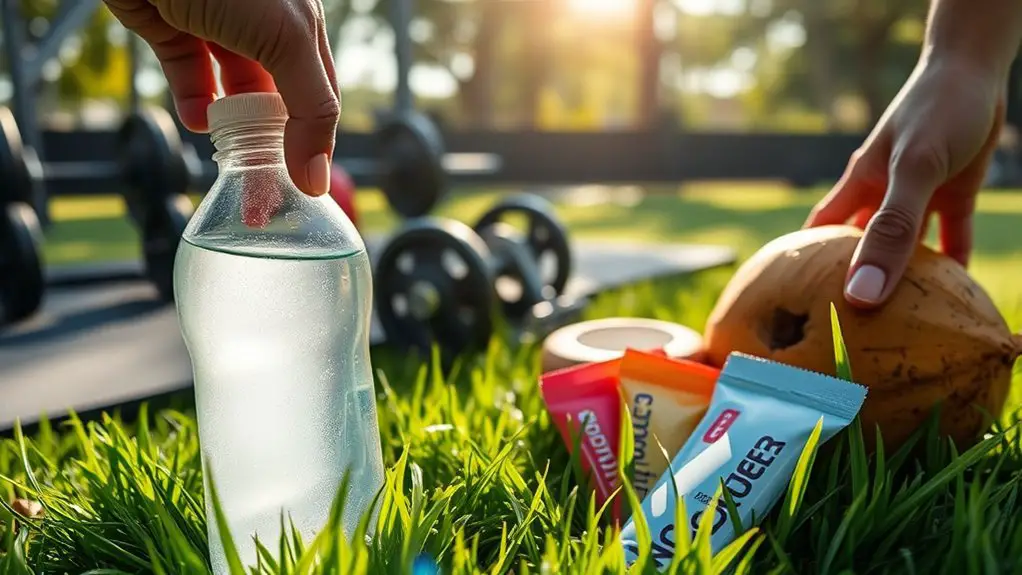
Proper nutrition is just one piece of the recovery puzzle; hydration is equally important for gym athletes. To optimize your recovery, focus on hydration timing—drink fluids before, during, and after your workouts. Aim for around 16-20 ounces of water two hours prior to exercising and replenish every 15-20 minutes during your session to maintain peak performance.
Post-workout, rehydrate with a mix of water and electrolyte-rich beverages to restore your electrolyte balance. This is essential, as sweating can lead to significant loss of sodium, potassium, and magnesium, which are critical for muscle function and recovery.
Keep track of your hydration levels by monitoring the color of your urine; pale yellow indicates proper hydration. Adjust your intake based on your workout intensity and duration. By implementing effective hydration strategies, you’ll enhance recovery, boost performance, and reduce the risk of injury.
Stretching and Flexibility Exercises
Incorporating stretching and flexibility exercises into your routine is essential for enhancing recovery and preventing injuries. These practices not only improve your range of motion but also aid in muscle recovery post-workout. Here are four key methods to contemplate:
Incorporating stretching into your routine enhances recovery, prevents injuries, and improves overall flexibility and range of motion.
- Dynamic Stretching: Engage in dynamic stretches before workouts to warm up your muscles and increase blood flow. This prepares your body for the intensity of your training.
- Static Stretching: Post-workout, use static stretching to lengthen your muscles and improve flexibility. Hold each stretch for 15-30 seconds for optimum benefits.
- Flexibility Routines: Incorporate regular flexibility routines throughout the week. This consistency can greatly enhance overall mobility and performance.
- Injury Prevention: Prioritize stretching to reduce the risk of strains and sprains. A well-rounded approach will keep you active and injury-free.
Foam Rolling and Self-Myofascial Release

When you’re looking to enhance your recovery, foam rolling and self-myofascial release (SMR) can be game-changers. These techniques help alleviate muscle tightness, improve flexibility, and promote overall recovery. By applying pressure to specific areas, you’re fundamentally releasing tension in the fascia, which can lead to better performance.
Here’s a quick guide to some effective foam roller techniques and their benefits:
| Foam Roller Technique | Myofascial Release Benefits |
|---|---|
| Quadriceps Roll | Reduces knee pain and improves mobility |
| Hamstrings Roll | Alleviates tightness and enhances flexibility |
| Upper Back Roll | Releases tension and improves posture |
| Glutes Roll | Eases hip pain and aids recovery |
Incorporating these techniques into your routine can maximize myofascial release benefits, ultimately making your workouts more effective. So, grab a foam roller and start rolling!
Sleep and Its Impact on Recovery
Sleep plays an essential role in your recovery process, as both the duration and quality of your rest can greatly affect muscle repair and overall performance. Factors like sleep environment and bedtime routines can enhance your sleep quality, leading to better recovery outcomes. Additionally, incorporating short naps can provide an extra boost to your energy levels and help you bounce back faster after intense workouts.
Sleep Duration Importance
Getting enough quality sleep is essential for gym athletes, as it directly influences recovery and performance. Insufficient sleep can lead to sleep deprivation, impairing your results. Here’s why sleep duration matters:
- Muscle Repair: Sleep allows your body to repair and grow muscle tissues, fundamental after intense workouts.
- Hormonal Balance: Adequate sleep regulates hormones like cortisol and testosterone, crucial for recovery and muscle growth.
- Cognitive Function: Proper sleep enhances focus and decision-making, improving your training sessions and workout efficiency.
- Sleep Cycles: Engaging in complete sleep cycles fosters deep sleep, necessary for physical recovery and emotional well-being.
Prioritize your sleep schedule to maximize your gains and guarantee a better performance in the gym.
Sleep Quality Factors
While many athletes focus on the quantity of sleep, the quality of that sleep plays an equally critical role in recovery. To enhance your sleep quality, start with sleep environment optimization. Make certain your bedroom is dark, cool, and quiet, as these factors greatly impact how well you rest. Consider using blackout curtains and white noise machines for a more conducive atmosphere.
Additionally, practice effective sleep cycle management by adhering to a consistent sleep schedule. Going to bed and waking up at the same time daily helps regulate your body’s internal clock, promoting deeper sleep stages. Incorporating relaxation techniques before bedtime, like meditation or gentle stretching, can also improve your overall sleep quality, leading to better recovery and performance in the gym.
Napping Benefits for Recovery
Have you ever considered how a short nap might enhance your recovery after intense workouts? Napping can be a powerful recovery tool, but it’s essential to utilize effective napping techniques for the best results. Here are some benefits of napping:
- Improved Muscle Recovery: Naps can boost protein synthesis, aiding muscle repair.
- Enhanced Mental Focus: A quick nap can rejuvenate your mind, keeping you sharp for your next session.
- Reduced Fatigue: Short naps can combat post-workout tiredness, helping you feel more energized.
- Optimal Duration: Aim for 20-30 minutes for a quick refresh, avoiding longer naps that might disrupt your nighttime sleep.
Incorporating strategic naps into your routine can greatly elevate your recovery process.
Cold Therapy and Contrast Baths
Cold therapy and contrast baths are effective recovery methods that can greatly reduce muscle soreness and inflammation. You can easily incorporate these techniques into your routine, but it’s crucial to know how to perform them correctly and when to use them for maximum benefits. Let’s explore the advantages of cold therapy and the best practices for contrast baths, including timing and frequency recommendations.
Benefits of Cold Therapy
Many athletes swear by cold therapy as an essential part of their recovery routine. Cold exposure helps reduce muscle soreness and inflammation, allowing you to recover faster and perform better. Here are four key benefits of incorporating cold therapy into your regimen:
- Reduces Inflammation: Cold therapy constricts blood vessels, reducing swelling and inflammation in sore muscles.
- Eases Muscle Soreness: By numbing the affected areas, it alleviates pain and discomfort caused by intense workouts.
- Enhances Recovery Speed: Cold exposure speeds up recovery time, getting you back to training sooner.
- Improves Circulation: Following cold therapy, blood flow increases as vessels dilate, delivering essential nutrients to muscles.
Incorporating these benefits can greatly enhance your recovery process.
How to Perform Contrast Baths
One effective method for enhancing recovery is performing contrast baths, which alternate between hot and cold water immersion. To use the contrast bath technique, start by filling one tub with hot water (around 100-110°F) and another with cold water (around 50-60°F). Immerse yourself in the hot water for about 3-4 minutes, then switch to the cold water for 1-2 minutes. Repeat this cycle for 15-20 minutes. This method helps with temperature regulation, promoting better blood circulation and reducing muscle soreness. It’s essential to listen to your body; if you feel uncomfortable, adjust the temperatures or immersion times. Contrast baths can be a powerful tool in your recovery arsenal, so give it a try!
Timing and Frequency Recommendations
While timing and frequency are essential for maximizing the benefits of cold therapy and contrast baths, understanding your body’s needs is equally important. Here are some timing strategies and frequency guidelines to take into account:
- Post-Workout: Apply cold therapy within 30 minutes after intense workouts for ideal recovery.
- Duration: Limit cold exposure to 10-15 minutes to prevent skin damage.
- Frequency: Use contrast baths 2-3 times a week, especially after heavy training sessions.
- Listen to Your Body: Adjust your routine based on how your body feels; if soreness persists, increase frequency.
Massage Therapy Techniques
Massage therapy techniques play an essential role in aiding recovery for gym athletes by relieving muscle tension, improving circulation, and enhancing overall performance. Incorporating various methods can optimize your recovery. Trigger point therapy targets specific tight areas, while deep tissue massage focuses on deeper layers of muscle, helping alleviate chronic tension. Sports massage is specifically designed to prepare your body before a workout and aid recovery afterward; consider a pre-event massage to enhance performance and a post-event massage to reduce soreness. Myofascial release techniques work on the fascia, improving flexibility and reducing pain. Additionally, relaxation techniques during massage can help lower stress levels, contributing to better recovery outcomes. The massage benefits extend beyond immediate relief, supporting long-term muscle health and performance enhancement. By integrating these techniques into your routine, you can guarantee a more effective recovery process and maintain your athletic edge.
Advanced Recovery Technologies
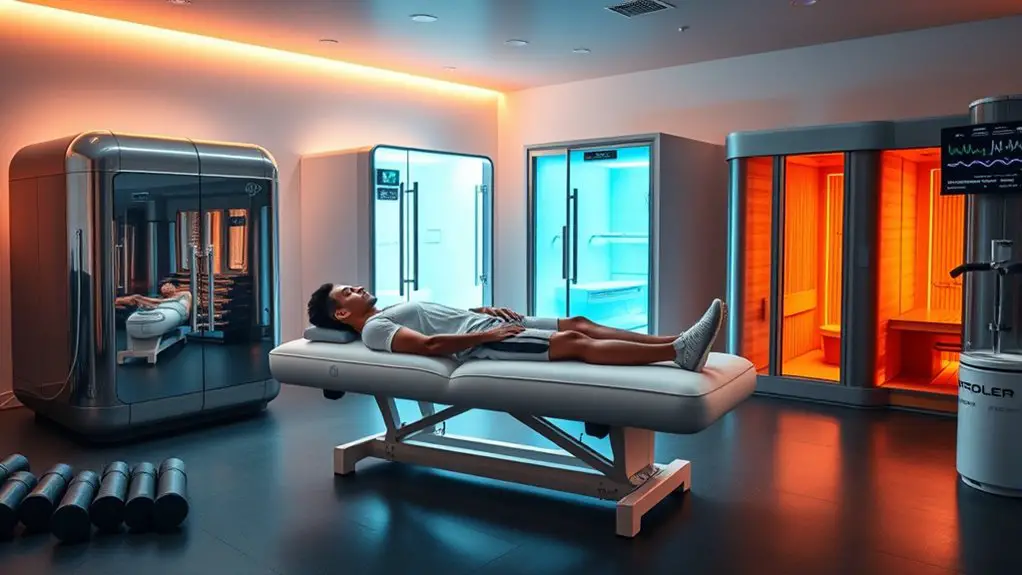
As recovery becomes increasingly essential for gym athletes aiming for peak performance, advanced recovery technologies offer innovative solutions to enhance the healing process. Integrating these methods into your routine can greatly improve recovery time and overall well-being. Here are four key technologies you should consider:
- Cryotherapy: Utilizing extreme cold, this technique reduces inflammation and speeds up muscle recovery, providing numerous cryotherapy benefits like pain relief and improved circulation.
- Infrared Saunas: These saunas use infrared light to penetrate your skin, promoting detoxification and enhanced blood flow, which aids in muscle recovery.
- Compression Therapy: Using inflatable garments, compression therapy helps reduce muscle soreness and swelling by improving circulation.
- Electrical Stimulation: This technique stimulates muscle contractions, aiding in recovery and reducing pain by promoting blood flow to injured areas.
Incorporating these technologies can help you recover faster and perform better.
Frequently Asked Questions
How Long Should I Rest Between Intense Workout Sessions?
You should aim for 48 to 72 hours of rest between intense workout sessions to allow your muscles to recover effectively. This rest interval helps reduce the risk of injury and improves overall performance. If you’re training multiple muscle groups, consider adjusting your workout frequency to guarantee adequate recovery. Listening to your body is vital; if you’re still sore or fatigued, it might be a sign that you need more rest before your next session.
Can Mental Health Affect Physical Recovery Rates?
Studies show that individuals with higher mental resilience can recover from physical stress up to 50% faster. This highlights how mental health greatly affects your physical recovery rates. When you prioritize your emotional well-being, you’re not just boosting your mood; you’re enhancing your body’s ability to heal. Stress and anxiety can slow down recovery, so incorporating mindfulness or relaxation techniques can be beneficial. Remember, a healthy mind supports a healthy body!
What Are the Signs of Overtraining?
When you’re pushing your limits, it’s essential to recognize overtraining symptoms. You might notice fatigue indicators like persistent tiredness, decreased performance, or irritability. Sleep disturbances and increased muscle soreness can also signal that you’re overdoing it. Pay attention to these signs; they can help prevent burnout and injuries. If you’re experiencing multiple symptoms, it might be time to adjust your routine and prioritize recovery. Listening to your body is key to long-term success.
Should I Take Supplements for Faster Recovery?
Imagine your body as a finely tuned machine, craving the right fuel to keep running smoothly. While supplements can aid recovery, focusing on protein timing and hydration strategies is essential. Consuming protein shortly after workouts helps repair muscles, while staying hydrated enhances nutrient absorption. Instead of relying solely on supplements, consider a balanced diet rich in whole foods. If you choose to supplement, consult a healthcare professional to make sure it aligns with your goals and needs.
How Does Age Influence Recovery Techniques?
Age can greatly influence your recovery strategies due to age-related adaptations in your body. As you get older, your muscle recovery may slow down, meaning you might need to adjust your techniques. Incorporating more rest days, focusing on nutrition, and incorporating gentle stretching or yoga can be beneficial. Additionally, you might find that hydration and proper sleep become even more essential for effective recovery as you age.
